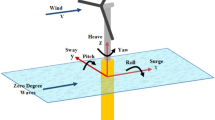Abstract
This paper presents an application of gain-scheduling (GS) control techniques to a floating offshore wind turbine on a barge platform for above rated wind speed cases. Special emphasis is placed on the dynamics variation of the wind turbine system caused by plant nonlinearity with respect to wind speed. The turbine system with the dynamics variation is represented by a linear parameter-varying (LPV) model, which is derived by interpolating linearized models at various operating wind speeds. To achieve control objectives of regulating power capture and minimizing platform motions, both linear quadratic regulator (LQR) GS and LPV GS controller design techniques are explored. The designed controllers are evaluated in simulations with the NREL 5MWwind turbine model, and compared with the baseline proportional-integral (PI) GS controller and non-GS controllers. The simulation results demonstrate the performance superiority of LQR GS and LPV GS controllers, as well as the performance trade-off between power regulation and platform movement reduction.
Similar content being viewed by others
References
S. Mathew. Wind Energy: Fundamentals, Resource Analysis and Economics. Berlin: Springer, 2006.
W. Musial, S. Butterfield, B. Ram. Energy from offshore wind Proceedings of Offshore Technology Conference, Houston, Texas: 2006: 1888–1898.
D. Roddier, C. Cermelli, A. Aubault, et al. Wind Float: A floating foundation for offshore wind turbines. Journal of Renewable and Sustainable Energy, 2010, 2(3): DOI 10.1063/1.3435339.
C. P. Butterfield, W. Musial, J. M. Jonkman, et al. Engineering Challenges for Floating Offshore Wind Turbines. Golden Colorado: National Renewable Energy Laboratory, 2007.
J. M. Jonkman, S. Butterfield, W. Musial, et al. Definition of a 5-MW Reference Wind Turbine for Offshore System Development, Golden Colorado: National Renewable Energy Laboratory, 2009.
J. M. Jonkman, M. L. Buhl. FAST User’s Guide. Golden Colorado: National Renewable Energy Laboratory, 2005.
G. Betti, M. Farina, G. Guagliardi, et al. Development of a control-oriented model of floating wind turbines. IEEE Transactionos onControl Systems Technology, 2014, 22(1): 69–82.
P. J. Moriarty, S. B. Butterfield. Wind turbine modeling overview for control engineers. Proceedings of the American Control Conference. St. Louis: IEEE, 2009: 2090–2095.
J. W. Van Wingerden, I. Houtzager, F. Felici, et al. Closed-loop identification of the time-varying dynamics of variable-speedwind turbines. International Journal of Robust and Nonlinear Control, 2009, 19(1): 4–21.
T. Bakka, H. R. Karimi. Robust output feedback H∝ control synthesis with pole placement for offshore wind turbine system:An LMI approach. Proceedings of IEEE International Conference on Control Applications, Dubrovnik: IEEE, 2012: 1467–1472.
M. A. Lackner, M. A. Rotea. Structural control of floating windturbines. Mechatronics, 2011, 21(4): 704–719.
E. Lindeberg. Optimal Control of Floating Offshore Wind Turbines. Trondheim, Norway: Norwegian University of Science andTechnology, 2009.
H. Namik, K. Stol. Individual blade pitch control of floating offshore wind turbines. Wind Energy, 2010, 13(1): 74–85.
H. Namik, K. Stol. Performance analysis of individual blade pitch control of offshore wind turbines on two floating platforms. Mechatronics, 2011, 21(4): 691–703.
T. Bakka, H. R. Karimi, N. A. Duffie. Gain scheduling for output H∝ control of offshore wind turbine. Proceedings of the 22nd International Offshore and Polar Engineering Conference. Rhodes, Greece, 2012: 496–501.
J. M. Jonkman. Dynamics Modeling and Loads Analysis of An Offshore Floating Wind Turbine. Golden Colorado: National Renewable Energy Laboratory, 2007.
J. R. Homer, R. Nagamune. Control-oriented physics-based models for floating offshore wind turbines. Proceedings of the American Control Conference. Chicago, Illinois: IEEE, 2015.
P. Apkarian, R. J. Adams. Advanced gain-scheduling techniques for uncertain systems. IEEE Transactions on Control Systems Technology, 1998, 6(1): 21–32.
T. Burton, N. Jenkins, D. Sharpe, et al. Wind Energy Handbook. New York: John Wiley & Sons, 2011.
B. J. Jonkman. TurbSim User’s Guide: Version 1.50. Golden Colorado: National Renewable Energy Laboratory, 2009.
Author information
Authors and Affiliations
Corresponding author
Additional information
This work was supported by the Natural Sciences and Engineering Research Council of Canada (NSERC) (No. 11R82911) and the Institute of Computing, Information and Cognitive Systems (ICICS) at the University of British Columbia.
Omid BAGHERIEH received the B.Sc. degreein Mechanical Engineering from the Sharif University of Technology, Tehran,Iran, in 2011, and the M.Sc. degree in Mechanical Engineering from the Universityof British Columbia, Vancouver, Canada, in2013. Since 2013, he has been with the Departmentof Mechanical Engineering, University of California, Berkeley, as a Ph.D.candidate. His current research interests include control applications to servo systems and wind turbines.
Ryozo NAGAMUNE received the B.Sc. and M.Sc. degrees from the Department of Control Engineering, Osaka University, Japan, in1995 and 1997, respectively, and the Ph.D.degree from the Division of Optimization and Systems Theory, Royal Institute of Technology, Stockholm, Sweden, in 2002. From 2003 to 2006, he was a postdoctoral researcher at the Mittag-Leffler Institute, Universityof California at Berkeley, Berkeley, CA, U.S.A., and the Royal Institute of Technology. He has been with the Department of Mechanical Engineering, The University of British Columbia, Vancouver, BC, Canada, since August 2006, where he is currently an associate professor. From September to December 2013, he was a visiting researcher at the National Wind Technology Center of the National Renewable Energy Laboratory, Golden, CO, U.S.A. His research interests include robust control theory and applications to mechatronics systems, suchas hard disk drives, machine tool drives, automotive engines, andwind turbines. Dr. Nagamune received the IEEE CDC Best Student Paper Award in 2001, and the Best Paper Award at the 23rd Canadian Congress of Applied Mechanics in 2011. He is an associate editor ofthe ASME Journal of Dynamic Systems, Measurement and Control.He is a chair of the IEEE Joint Chapter of Control Systems, Robotics and Automation, and Systems, Man, and Cybernetics Societies in theVancouver Section. He received the Canada Research Chair, Tier 2, inControl Engineering.
Rights and permissions
About this article
Cite this article
Bagherieh, O., Nagamune, R. Gain-scheduling control of a floating offshore wind turbine above rated wind speed. Control Theory Technol. 13, 160–172 (2015). https://doi.org/10.1007/s11768-015-4152-0
Received:
Revised:
Accepted:
Published:
Issue Date:
DOI: https://doi.org/10.1007/s11768-015-4152-0




